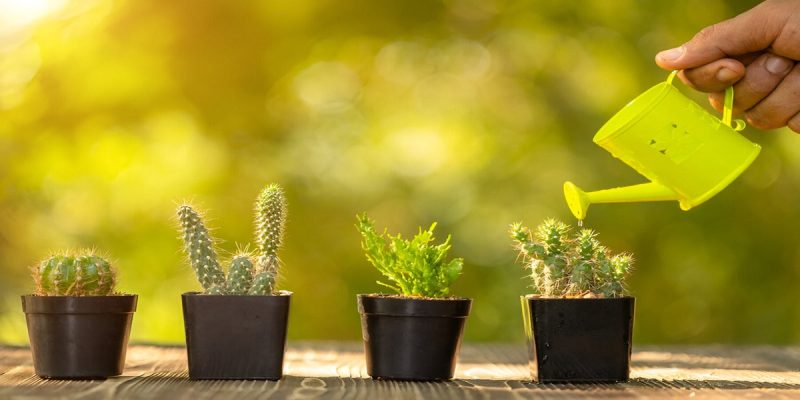Cacti are among the most popular and resilient plants for indoor and outdoor gardening. Known for their unique shapes, striking flowers, and ability to thrive in arid conditions, cacti have won the hearts of many plant enthusiasts. However, despite their hardy reputation, one of the most common questions for cactus owners is how often they should water these desert dwellers. Overwatering or underwatering can lead to serious health problems for cacti, so understanding their watering needs is crucial.
This complete guide explores how often to water a cactus, factors influencing watering frequency, signs of improper watering, and tips for maintaining a healthy cactus.
Table of Contents
Understanding the Water Needs of Cacti

Cacti have evolved to survive in dry, harsh environments with minimal water. Their thick, fleshy stems store water, allowing them to endure long periods of drought. Unlike typical houseplants, cacti require less frequent watering, but this does not mean they need no water at all. Their water needs vary depending on the species, size, age, and environmental conditions.
During their active growing season, which is typically in the warmer months, cacti require more water to support growth and flowering. In contrast, during their dormant period, often in cooler months, water needs decrease significantly as the plants enter a state of rest. Understanding this cycle is essential to provide the right amount of water at the right time.
Factors Affecting How Often You Should Water a Cactus
Climate and Environment
The climate and environment where a cactus is grown significantly impact its watering needs. Cacti grown outdoors in hot, dry, and sunny climates will typically require more frequent watering than those grown indoors or in cooler, more humid environments. Indoor cacti are often exposed to controlled temperatures and humidity levels, which may reduce their water requirements.
Soil Type and Drainage
Cacti need well-draining soil to prevent water from sitting around their roots, which can cause rot. Soil that retains too much moisture will increase the risk of overwatering. The type of soil mixture, whether it’s a commercial cactus mix or a homemade blend with sand, perlite, or gravel, affects how quickly water drains and thus influences how often you should water.
Size and Age of the Cactus
Smaller or younger cacti generally require more frequent watering than mature, larger plants. This is because smaller plants have less stored water and their roots are still developing, making them more sensitive to dry conditions. Mature cacti have larger water reservoirs in their stems, allowing them to withstand longer intervals without water.
Pot Size and Material
The size and material of the pot also influence watering frequency. Smaller pots dry out faster and may require more frequent watering. Similarly, porous materials like terracotta absorb moisture and can cause the soil to dry out more quickly, whereas plastic or glazed pots retain moisture longer.
How Often Should You Water a Cactus During Different Seasons?
Watering Frequency During Growing Season
During the cactus growing season, typically spring and summer, watering should be more regular to support active growth. Depending on environmental conditions, watering every one to two weeks is common. However, the best approach is to check the soil moisture before watering. The top inch or two of soil should be dry before adding water. Overwatering during this period can lead to root rot and other issues.
Watering Frequency During Dormant Season
In fall and winter, most cacti enter dormancy, slowing down their growth significantly. During this period, they require far less water. Watering once a month or even less is usually sufficient. Some cacti may survive without water for several months, especially in cooler indoor environments.
Signs Your Cactus Needs Water
Recognizing when your cactus needs watering is vital to avoid under or overwatering. Common signs that a cactus requires water include slight wrinkling or shriveling of the stem, dull or faded color, and softness when gently squeezed. However, these signs can sometimes be subtle, so regular checks of soil moisture help prevent stress.
Signs of Overwatering and How to Avoid It
Overwatering is one of the most common causes of cactus death. Signs include yellowing or blackening of the stem, mushy texture, and a foul smell from the soil. The roots may rot, and the plant can collapse. To avoid overwatering, always ensure the soil is dry before watering and use pots with drainage holes.
Tips for Watering Your Cactus Properly
Use the Soak and Dry Method
Water your cactus thoroughly until water drains out of the pot’s drainage holes, then allow the soil to dry out completely before watering again. This mimics natural desert conditions where heavy rains are followed by dry spells.
Adjust Watering Based on Environment
Monitor your cactus’s environment and adjust watering frequency accordingly. Hotter and sunnier spots require more frequent watering than shaded or cooler areas.
Use Proper Tools
Using a watering can with a narrow spout or a spray bottle allows precise watering without soaking the entire plant, which is especially useful for smaller cacti.
FAQs About Watering Cacti
How often should I water my cactus indoors?
Indoor cacti typically need watering every 2 to 4 weeks during their growing season, but always check the soil moisture before watering to avoid overwatering.
Can cacti survive if I forget to water them for a long time?
Yes, cacti are drought-tolerant plants and can survive long periods without water, but extended neglect can stress the plant and affect its health.
What is the best watering method for cacti?
The soak and dry method is best: water thoroughly until it drains out, then let the soil dry completely before watering again.
How can I tell if I’m overwatering my cactus?
Signs include yellowing, mushy stems, and a foul smell from the soil. Overwatering often leads to root rot, which can kill the cactus.
Do all cactus species require the same watering frequency?
No, watering needs vary by species, size, and environment. Desert cacti generally need less water than tropical cacti.
Conclusion
Watering a cactus might seem simple, but getting the frequency right is key to keeping your plant healthy and thriving. By understanding your cactus’s needs, paying attention to environmental factors, and observing your plant’s condition, you can develop an effective watering routine. Whether you have a small indoor cactus or a large outdoor collection, this guide helps ensure your cactus stays hydrated without the risk of overwatering.






